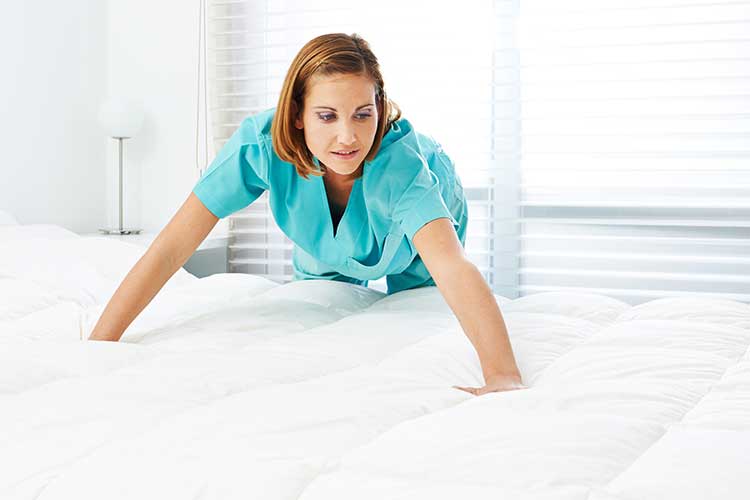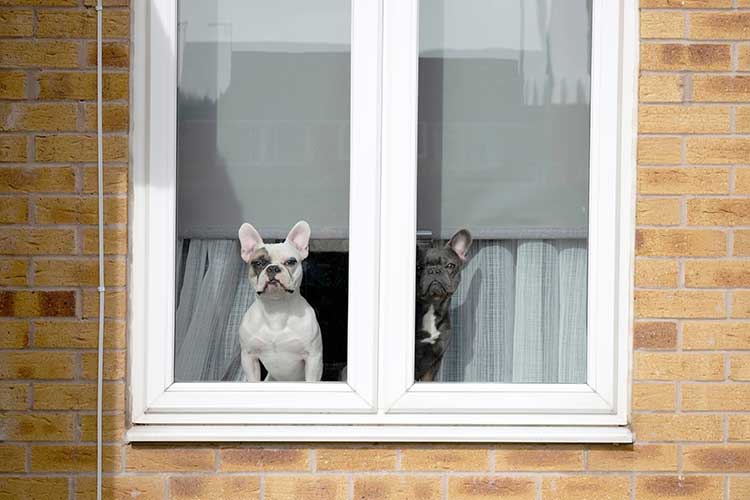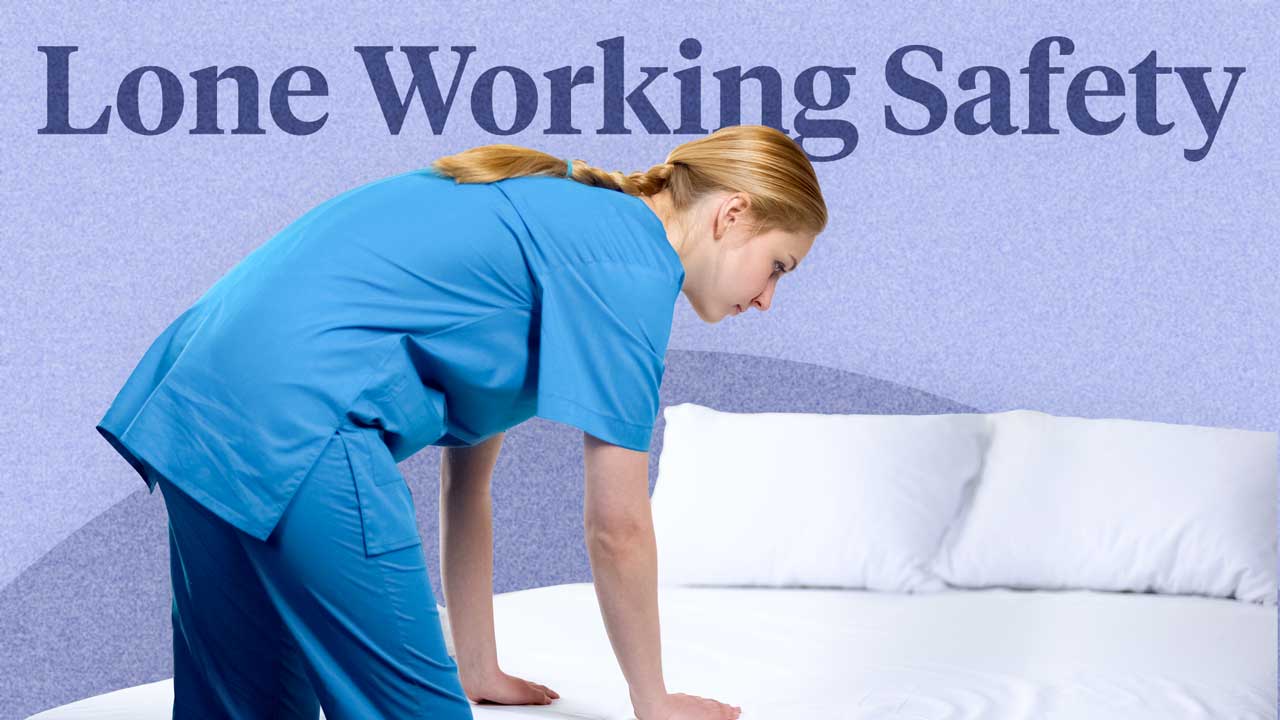An Australian report found that 69% of home care workers have felt unsafe in a client’s home (Skatssoon 2019).
Furthermore, 45% have been injured at work, and 60% have experienced workplace abuse (Skatssoon 2019).
As a home care worker, you will often find yourself alone in diverse and unpredictable environments. Home care presents a unique set of challenges and risks, ranging from hazards in the client’s home to car accidents while travelling between work locations.
In order to stay safe while working, it is essential to be aware of potential risks and appropriately manage difficult and dangerous situations. Although you have a duty of care to your clients, you also have a duty of care to yourself (Workplace Health and Safety Queensland 2018).
And, as the client’s home is considered a workplace, the client also owes you a duty of care and is expected to disclose any hazards they become aware of (DMIRS 2019).

The Risk Management Process
When working alone in a client’s home, you will need to assess and manage potential risks.
There are four steps of the risk management process:
- Identify hazards: Determine what has the potential to cause harm.
- Assess risks: Determine the harm that could be caused by the hazard, how serious the potential harm could be and how likely it is to occur.
- Control risks: Implement appropriate control measures. The following hierarchy of control measures lists possible strategies from most effective to least effective:
- Eliminate the risk.
- Either:
- Substitute the hazard
- Isolate the hazard, or
- Implement engineering controls
- Reduce exposure to the hazard using administrative controls.
- Use PPE.
- Review control measures: Assess the effectiveness of the control measures.
(Safe Work Australia 2022)
Identifying Hazards in Home Care
It’s important to remember that clients are generally receiving home care because illness, age or other factors are causing them to have difficulty managing certain tasks on their own. For this reason, their homes may be unclean, unmaintained or deteriorating. Generally, clients’ homes will not be in the same condition as a normal, regulated workplace (Bien 2020).
This is in addition to the client’s home being an unfamiliar environment.
Below are some of the potential hazards encountered by home care workers.
Manual Handling
Manual handling is any work that requires lifting, lowering, pushing, pulling, carrying, moving, holding or restraining. It is the biggest cause of workplace injuries in Australia (WorkSafe Victoria 2022).
Manual handling tasks do not necessarily involve large or heavy objects; even using a keyboard is considered manual handling (WorkSafe Victoria 2022).
Not every manual task has the potential to cause harm, but you are at increased risk if the work involves:
- Repeated or sustained application of force
- Awkward posture
- Repeated movements
- The use of high force
- Sustained vibration
- Handling people or animals
- Handling unstable, unbalanced or difficult-to-grasp loads.
(WorkSafe Victoria 2022)
Manual tasks can become riskier in residential environments, as most homes are not designed for healthcare purposes and may have confined spaces that make tasks more challenging (Workplace Health and Safety Queensland 2018).
Common manual handling tasks in home care include:
- Transferring, bathing or dressing clients
- Pushing wheelchairs
- Loading and unloading from vehicles
- Moving furniture
- Gardening and maintenance
- Cleaning (e.g. vacuuming, mopping)
- Making beds
- Transporting clients
- Other domestic tasks.
(Workplace Health and Safety Queensland 2018; WorkSafe Victoria 2011)
Injuries from hazardous manual handling can occur suddenly or develop gradually. In some cases, hazardous manual handling may lead to long-term musculoskeletal disorders that significantly impede on quality of life (Workplace Health and Safety Queensland 2018; WorkSafe Victoria 2022).

Violence, Abuse and Aggression
This relates to any incident at work wherein you are abused, threatened or assaulted by either the client, other members of the household or the general public (DMIRS 2019). This may include:
- Biting, spitting, scratching, hitting or kicking
- Throwing objects
- Pushing, shoving, tripping or grabbing
- Verbal threats
- Sexual assault
- The use of weapons such as knives or guns.
(DMIRS 2019)
Violent behaviour poses a significant risk to home care workers, as they often work alone and after dark, and may result in physical or psychological harm (Workplace Health and Safety Queensland 2018; DMIRS 2019).
Clients may become aggressive for a variety of reasons including medication, illness and cognitive impairment. You may accidentally trigger a behavioural response from a client you are unfamiliar with. The layout of the client’s home may also make it difficult for you to remove yourself from the situation (DMIRS 2019).
Biological Hazards
Home care workers may be exposed to infectious diseases or body substances through tasks such as:
- Performing health and personal care for clients
- Handling items and equipment around the home
- Cleaning (including spills and body substances)
- Laundry
- Handling sharps
- Food handling and storage.
(Workplace Health and Safety Queensland 2018)
Slips, Trips and Falls
A significant number of injuries in community care are caused by slips, trips and falls. Hazards in the client’s home may include:
- Spills
- Objects on the floor (e.g. plastic bags)
- Slippery floor surfaces, particularly in bathrooms and toilets
- Uneven flooring
- Cluttered walkways
- Loose mats or tiles
- Electrical cords
- Poor lighting or visibility
- Stairs and ladders
- Space and design of the home.
(DMIRS 2019; Workplace Health and Safety Queensland 2018)
Driving

Throughout the day, you may need to drive between a variety of locations. These can include client homes, your facility and other destinations (when transporting clients) (Workplace Health and Safety Queensland 2018). Hazards when driving include:
- Poor weather
- Poor road conditions
- Fatigue
- Rushing
- Distractions (e.g. mobile phone, the client)
- Unfamiliar vehicles
- Client behaviour
- Disregarding road rules
- Changes to usual routes
- Driving in remote or isolated areas.
(Workplace Health and Safety Queensland 2018)
Other Potential Hazards
- Isolated or remote work
- Hazardous substances and chemicals
- Electrical hazards
- Latex allergy
- Stress
- Fatigue.
(Workplace Health and Safety Queensland 2018)
Implementing Control Measures
The following table outlines strategies for dealing with hazards in clients’ homes.
| Manual handling |
|
| Violence, Abuse and Aggression |
|
| Biological Hazards |
|
| Slips, Trips and Falls |
|
| Driving |
|
(DMIRS 2019; Workplace Health and Safety Queensland 2018)
General Safety Tips for Home Care Workers
- Always wear shoes in the client’s home. If the client objects to this, disposable surgical shoe covers or a clean pair of shoes solely for wearing inside may be a suitable alternative.
- Never touch the client’s pets. Ask for them to be kept away while you visit.
- Confirm the visit with the client before you arrive.
- Ensure you have detailed directions to a new client’s home.
- Leave your bag in the boot of the car and keep the doors locked.
- Ensure somebody knows where you are at all times.
- If you ever feel uncomfortable or scared for your safety, remove yourself from the situation and call your supervisor and emergency services. Trust your instincts and never put yourself into a situation that makes you feel unsafe.
(Malugani 2022)

Being Aware of Changes
It’s important to remember that the client and their home may change between visits. Even if their home environment was safe previously, you cannot assume that it will still be in the same condition next time. In order to minimise the risk of harm, ensure you assess for hazards and changes every visit (Workplace Health and Safety Queensland 2018). Take note of:
- The client’s health status
- The placement and positioning of furniture
- Electrical equipment
- New furniture or equipment
- New people or animals
- Spills or leaks
- Obstructed areas
- Changes to the service being provided.
(Workplace Health and Safety Queensland 2018)
When to Report Incidents
You should report any incidents that result in injury to yourself or the client, an emergency situation or a near-miss (Workplace Health and Safety Queensland 2018).
Conclusion
Home care workers are required to care for clients in diverse and changing residential environments that are not subject to the same regulations as traditional healthcare workplaces. You must be able to recognise and control various hazards around the home to protect yourself and your clients from harm.
Furthermore, the solitary and independent nature of this work means that you must remain vigilant and be able to manage challenging situations on your own. Being familiar with the risk management process and being able to mitigate any identified risks is essential for personal safety.
Test Your Knowledge
Question 1 of 3
True or false: It is safe to touch the client’s pets during your visit.
Topics
References
- Bien, E 2020, ‘The Unique Occupational Environment of the Home Healthcare Worker’, NIOSH Science Blog, 29 September, viewed 29 August 2023, https://blogs.cdc.gov/niosh-science-blog/2020/09/29/hhcws/
- Department of Mines, Industry Regulation and Safety 2019, Home Based Care Information and Checklist, Government of Western Australia, viewed 29 August 2023, https://www.commerce.wa.gov.au/sites/default/files/atoms/files/home_based_care_2019.pdf
- Malugani, M 2022, Safety Tips for Home Healthcare Workers, Monster, viewed 29 August 2023, https://www.monster.com/career-advice/article/safety-tips-for-home-health-workers
- Safe Work Australia 2022, Identify, Assess and Control Hazards, Australian Government, viewed 29 August 2023, https://www.safeworkaustralia.gov.au/safety-topic/managing-health-and-safety/identify-assess-and-control-hazards/managing-risks
- Skatssoon, J 2019, ‘Home Care Workers Suffering Abuse, Injuries’, Australian Ageing Agenda, 17 October, viewed 28 August 2023, https://www.australianageingagenda.com.au/executive/home-care-workers-suffering-abuse-injuries/
- Workplace Health and Safety Queensland 2018, A Guide to Working Safely in People’s Homes, Queensland Government, viewed 28 August 2023, https://www.worksafe.qld.gov.au/__data/assets/pdf_file/0018/82503/community-working-safely-in-peoples-homes.pdf
- WorkSafe Victoria 2022, Hazardous Manual Handling Health and Safety Guide, Victoria State Government, viewed 29 August 2023, https://www.worksafe.vic.gov.au/hazardous-manual-handling-health-and-safety-guide
- WorkSafe Victoria 2011, Home Care - Occupational Health and Safety Compliance Kit, Victoria State Government, viewed 29 August 2023, https://content.api.worksafe.vic.gov.au/sites/default/files/2018-06/ISBN-Home-care-occupational-health-and-safety-compliance-kit-2011-06.pdf
Additional Resources
- Home Based Care Information and Checklist | Department of Mines, Industry Regulation and Safety
- Safe Work Australia
- A Guide to Working Safely in People’s Homes | Workplace Health and Safety Queensland
- Home Care - Occupational Health and Safety Compliance Kit | WorkSafe Victoria
- Introduction to Occupational Health and Safety (OHS) | Ausmed Article
- Manual Handling: An Overview | Ausmed Article
 New
New 
